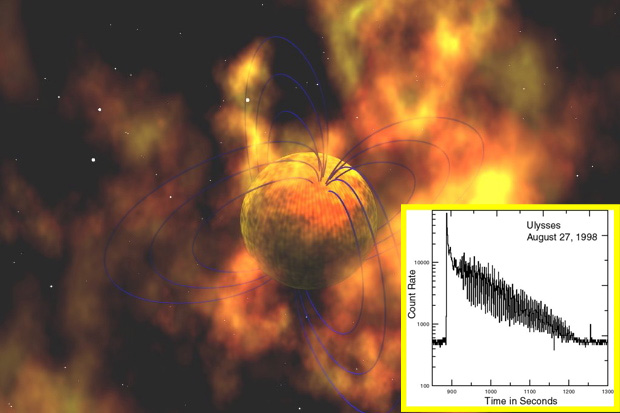
home •
about •
essential guide •
picture of the day •
thunderblogs •
news •
multimedia •
predictions •
products •
get involved •
contact

Credit: Robert Mallozzi (UAH, MSFC)
Insert credit: Kevin Hurley (Space Sciences Laboratory), Ulysses
pic of the day
archive
subject index
abstract
archive
Links:
Society for
Interdisciplinary
Studies
Feb 24, 2005
Magnetars–A Computer's Dream World
A magnetar is an invention derived from a computer, not something actually seen in the sky. What astronomers actually see are intense magnetic fields that pulsate in seconds or even in fractions of a second. And occasionally, sometimes repeatedly, magnetars emit a burst of gamma rays. From 50,000 light years away and for a tenth of a second, the most energetic burst ever detected momentarily outshone the full moon. So astronomers asked a computer if it could produce something like this extraordinary event using a model based only on the forces of gravity and magnetism.
Freed from the world of observation and experiment, the computer program hummed and churned, initially constructing a picture of a highly magnetized and rapidly spinning "neutron star" or "pulsar" (above). To explain the rapid pulsations, the computer extrapolated normal rotation rates of star-sized bodies down to objects compressed to a few kilometers diameter. And it was programmed with an additional unwarranted speculation. The program assumed that gamma ray bursts happen when “star quakes” disturb the solid surface of the neutron star and cause the magnetic field lines to snap apart and “reconnect” again. Had no one informed the computer of Hannes Alfvén’s admonition–that magnetic reconnection was "pseudoscience”? (See link below for more on “magnetic reconnection.”)
Plasma cosmologists, whose training is in electric circuits in plasma, do not ask their computers the questions asked by astronomers. Since 99% of the universe is composed of plasma, could the electrical behavior of plasma in the laboratory and in nearby space explain the observations of a magnetar? Plasma cosmologists know that magnetic fields don't stand alone, but are induced by electric currents. There must be an intense electric current feeding the magnetar, and this feeder current must be part of a circuit, since every electric circuit must close.
The electric model has no need for “super-fast rotation” of a collapsed star. Observed pulsations are the effect of resonances arising within the circuit. The occasional high-energy explosion is the release of stored electrical energy in a “double layer.” Double layers are capacitor-like structures that form wherever current flows in plasma. They are regions where the magnetohydrodynamic model used by astronomers breaks down because they have almost no magnetic properties. And since the exploding double layer draws energy from the entire circuit, the explosion can be far more energetic than expected from the energy locally present in the star. Plasma cosmologists study double layers regularly in their labs, and they recognize them in solar flares. They do not see objects in space as electrically neutral and isolated.
The energetic signature of the observed outbursts matches the characteristic signature of electric discharge. The outburst begins with a sudden peak of energy, and then declines gradually. (See insert of a Ulysses satellite record of a magnetar's explosive event). In contrast, the model for “magnetic reconnection” called for a long, low and steady energy release.
Of course both explanations may be sound in a purely mathematical sense. But one is rooted in observation and experiment, while the other relies almost exclusively on mathematics divorced from physical principles and is often contradicted by actual experience. So this approach with the exclusively magnetic model has consistently failed to predict the actual path of discovery.
The electric universe explanation rests on recognition of the electrical properties of plasma and on the scalability of plasma phenomena. It implies that electric discharge behavior observed on Earth and in the solar system has analogies on a macrocosmic scale, a prediction now confirmed by the pervasive signature of electric currents in deep space: magnetic fields, pulsations and explosive flares.
Since gravity is trivially weak in comparison to the electric force, it can only account for observed high-energy electrical effects through such mathematical conjectures as “collapsed super-dense matter” and “magnetic reconnection”. The mathematically conjured physical conditions have no analogies in anything seen in high-energy experiments–not even in the most sophisticated laboratories. And magnetic reconnection defies both logic and the principles of physics. For this reason, plasma cosmologists find the popular leap of faith to be extremely dubious.
More about the magnetic reconnection controversy here: Magnetic Reconnection
EXECUTIVE EDITORS:
David Talbott, Wallace Thornhill
MANAGING EDITOR: Amy Acheson
CONTRIBUTING EDITORS: Mel Acheson, Michael Armstrong, Dwardu Cardona,
Ev Cochrane, C.J. Ransom, Don Scott, Rens van der Sluijs, Ian Tresman
WEBMASTER: Michael Armstrong
Copyright 2005: thunderbolts.info